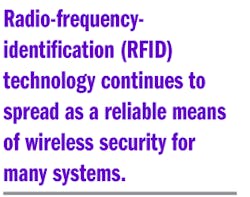Radio-frequency-identification (RFID) technology continues to spread as a reliable means of wireless security for many systems. These include readers that transmit signals to remotely power transceivers without batteries, which return signals to the reader at the same frequency. Effective operation requires adequate isolation between the two signals and the transmit and receive paths, which is typically achieved by two separate bistatic antennas or a single, switchable monostatic antenna.
Because both approaches can suffer from leakage of transmit power into the RFID reader, researchers Alirio Boaventura, Joao Santos, Arnaldo Oliveira, and Nuno Borges Carvalho of the Instituto de Telecomunicações, Departamento de Eletrònica, Telecomunicações e Informática, Universidade de Aveiro, Portugal, explored various self-jamming cancellation techniques for commercial RFID integrated circuits (ICs), including methods currently used in radar systems.
Such factors as signal reflections; RFID tag movement and resulting modulation from RFID tag antennas; lack of isolation from passive couplers in RFID antenna connections; and interference from nearby radio systems can result in jamming of RFID systems. Without sufficient isolation, power from these different sources can leak into the RFID receiver section and cause an overload of the receiver front end.
Through experimentation using baseband approaches, the researchers developed several approaches suitable for passive RFID designs based on algorithms that form lowpass filters (LPFs) and highpass filters (HPFs) for the removal of self-jamming interference in RFID systems. The approaches are meant to extend the range of passive RFID systems and, as the researchers explain, have already been adopted in a number of commercial RFID ICs. The techniques have proved effective in minimizing self-jamming effects for RFID systems even under transient operating conditions.
See “Perfect Isolation,” IEEE Microwave Magazine, Vol. 17, No. 11, November 2016, p. 20.
About the Author
Jack Browne
Technical Contributor
Jack Browne, Technical Contributor, has worked in technical publishing for over 30 years. He managed the content and production of three technical journals while at the American Institute of Physics, including Medical Physics and the Journal of Vacuum Science & Technology. He has been a Publisher and Editor for Penton Media, started the firm’s Wireless Symposium & Exhibition trade show in 1993, and currently serves as Technical Contributor for that company's Microwaves & RF magazine. Browne, who holds a BS in Mathematics from City College of New York and BA degrees in English and Philosophy from Fordham University, is a member of the IEEE.


